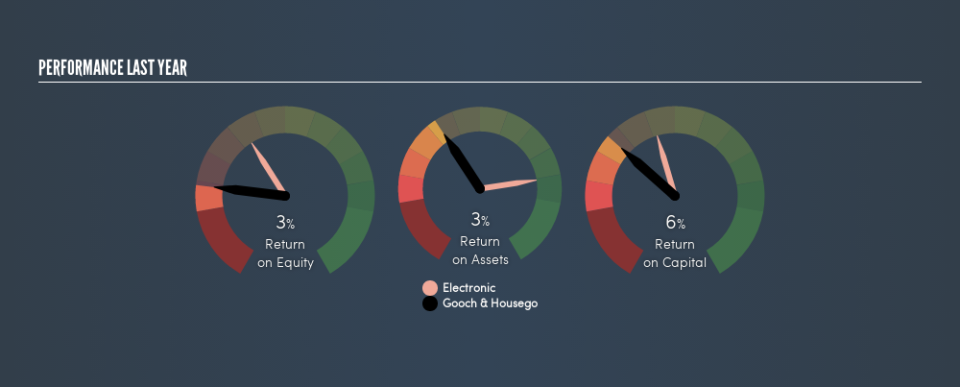Shareholders Should Look Hard At Gooch & Housego PLC’s (LON:GHH) 6.2% Return On Capital

Today we'll look at Gooch & Housego PLC (LON:GHH) and reflect on its potential as an investment. Specifically, we're going to calculate its Return On Capital Employed (ROCE), in the hopes of getting some insight into the business.
First up, we'll look at what ROCE is and how we calculate it. Next, we'll compare it to others in its industry. Last but not least, we'll look at what impact its current liabilities have on its ROCE.
Return On Capital Employed (ROCE): What is it?
ROCE is a metric for evaluating how much pre-tax income (in percentage terms) a company earns on the capital invested in its business. Generally speaking a higher ROCE is better. Overall, it is a valuable metric that has its flaws. Renowned investment researcher Michael Mauboussin has suggested that a high ROCE can indicate that 'one dollar invested in the company generates value of more than one dollar'.
So, How Do We Calculate ROCE?
Analysts use this formula to calculate return on capital employed:
Return on Capital Employed = Earnings Before Interest and Tax (EBIT) ÷ (Total Assets - Current Liabilities)
Or for Gooch & Housego:
0.062 = UK£9.1m ÷ (UK£174m - UK£28m) (Based on the trailing twelve months to March 2019.)
So, Gooch & Housego has an ROCE of 6.2%.
Check out our latest analysis for Gooch & Housego
Is Gooch & Housego's ROCE Good?
When making comparisons between similar businesses, investors may find ROCE useful. In this analysis, Gooch & Housego's ROCE appears meaningfully below the 12% average reported by the Electronic industry. This performance is not ideal, as it suggests the company may not be deploying its capital as effectively as some competitors. Setting aside the industry comparison for now, Gooch & Housego's ROCE is mediocre in absolute terms, considering the risk of investing in stocks versus the safety of a bank account. It is possible that there are more rewarding investments out there.
Gooch & Housego's current ROCE of 6.2% is lower than 3 years ago, when the company reported a 10% ROCE. Therefore we wonder if the company is facing new headwinds. You can click on the image below to see (in greater detail) how Gooch & Housego's past growth compares to other companies.
It is important to remember that ROCE shows past performance, and is not necessarily predictive. ROCE can be misleading for companies in cyclical industries, with returns looking impressive during the boom times, but very weak during the busts. This is because ROCE only looks at one year, instead of considering returns across a whole cycle. Future performance is what matters, and you can see analyst predictions in our free report on analyst forecasts for the company.
Do Gooch & Housego's Current Liabilities Skew Its ROCE?
Liabilities, such as supplier bills and bank overdrafts, are referred to as current liabilities if they need to be paid within 12 months. The ROCE equation subtracts current liabilities from capital employed, so a company with a lot of current liabilities appears to have less capital employed, and a higher ROCE than otherwise. To counteract this, we check if a company has high current liabilities, relative to its total assets.
Gooch & Housego has total liabilities of UK£28m and total assets of UK£174m. Therefore its current liabilities are equivalent to approximately 16% of its total assets. This very reasonable level of current liabilities would not boost the ROCE by much.
The Bottom Line On Gooch & Housego's ROCE
If Gooch & Housego continues to earn an uninspiring ROCE, there may be better places to invest. You might be able to find a better investment than Gooch & Housego. If you want a selection of possible winners, check out this free list of interesting companies that trade on a P/E below 20 (but have proven they can grow earnings).
If you like to buy stocks alongside management, then you might just love this free list of companies. (Hint: insiders have been buying them).
We aim to bring you long-term focused research analysis driven by fundamental data. Note that our analysis may not factor in the latest price-sensitive company announcements or qualitative material.
If you spot an error that warrants correction, please contact the editor at editorial-team@simplywallst.com. This article by Simply Wall St is general in nature. It does not constitute a recommendation to buy or sell any stock, and does not take account of your objectives, or your financial situation. Simply Wall St has no position in the stocks mentioned. Thank you for reading.


